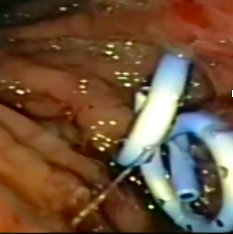Early (<4 weeks of illness) endoscopic drainage of pancreatic necrotic collections: Bold steps on unchartered territory!
Author: Prof Surinder S Rana, MD, DM, FASGE


Endoscopic transmural drainage has revolutionised the management of walled off necrosis (WON) and development of cautery enhanced lumen apposing metal stents (LAMS) has made endoscopic drainage of WON more safer and effective.1 Endoscopic drainage is attempted in necrotic collections that are encapsulated and located adjacent to the stomach or duodenum. WON usually develops >4 weeks after the onset of illness and therefore endoscopic transmural drainage is usually performed >4 weeks of onset of acute necrotising pancreatitis (ANP) after the collections get encapsulated. Symptomatic necrotic collections in the early phase (<4 weeks of illness) are drained either image guided percutaneously or surgically. Early (< 4weeks of illness) endoscopic transmural drainage of pancreatic necrotic collections (PNC) is usually not done because of fear of increased risk of complications including pneumoperitoneum and pneumo-retro-peritoneum. Moreover, studies evaluating early surgical necrosectomy have reported poor outcomes in comparison to delayed surgical necrosectomy. However, few recent endoscopic studies have challenged this traditional dogma of pancreatology.
Oblizajek et al studied 19 patients who underwent early endoscopic drainage of PNC and they reported that encapsulated collection was observed in 42% patients and both clinical as well as technical success with endoscopic transmural drainage was observed in all the patients.2 Importantly, there was no significant difference in the adverse events between early and delayed endoscopic drainage of PNC. Chantarojanasiri et al studied 35 patients (12 early and 23 delayed) with PNC who underwent endoscopic transmural drainage at a median time of 23 and 85 days after onset of ANP in the early and delayed drainage group respectively. The complications, mortality and clinical success were reported to be comparable between the two groups.
Trikudanathan et al compared the early (<4 weeks) endoscopic intervention in 76 patients (completely encapsulating wall in only 6.8% patients) in the early group with standard (>4 weeks) endoscopic intervention in 117 patients.4 Patients in the early drainage group had significantly increased mortality (13% vs. 4%, p = 0.02), need for rescue open necrosectomy (7% vs. 1%, p = 0.03) as well as median hospital (37 days vs. 26 days, p = 0.01) and ICU stay (median 2.5 days vs. 0 days, p = 0.001) with no significant difference in the frequency of complications. We also compared results of early endoscopic drainage in 34 patients (encapsulated wall in 74% patients) with results of delayed endoscopic drainage in 136 patients and observed that early endoscopic drainage of PNC is feasible and seems to be safe as well as effective but required significantly more number of endoscopic sessions as well as increased need for endoscopic necrosectomy for complete resolution. Moreover, early drainage seems to be associated with increased risk of complications as compared to delayed drainage.5 Preliminary data from our group also suggests that early endoscopic drainage seems to be associated with a shorter duration for resolution and infrequent need of salvage surgery compared to percutaneous drainage (PCD) with EPF formation being a significant adverse event with PCD.6
The results of these studies are encouraging and convey few important messages:
- Endoscopic transmural drainage of pancreatic necrotic collections is feasible in patients earlier than 4 weeks of onset of ANP and it seems to be safe and efficacious.
- The cut off of 4 weeks for endoscopic drainage is arbitrary. The pancreatic necrotic collections may get encapsulated completely or partially earlier than 4 weeks of onset of illness
- Early endoscopic transmural drainage is more challenging and is associated with increased risk of complications due to poorly formed wall as well as increased proportion of solid necrotic debris compared to WON in the delayed phase that has predominantly liquid content.
- Early endoscopic transmural drainage of PNC should be performed by skilled interventional gastroenterologist with extensive expertise in carefully selected group of patients along with a surgical as well as interventional radiological support.
References:
1. Rana SS. An overview of walled-off pancreatic necrosis for clinicians. Expert Rev Gastroenterol Hepatol 2019;13:331-343
2. Oblizajek N, Takahashi N, Agayeva S, et al. Outcomes of early endoscopic intervention for pancreatic necrotic collections: a matched case-control study. Gastrointestinal Endoscopy 2020;91:1303-1309
3. Chantarojanasiri T, Yamamoto N, Nakai Y, et al. Comparison of early and delayed EUS-guided drainage of pancreatic fluid collection. Endosc Int Open 2018;6:E1398-e1405
4. Trikudanathan G, Tawfik P, Amateau SK, et al. Early (<4 Weeks) Versus Standard (≥ 4 Weeks) Endoscopically Centered Step-Up Interventions for Necrotizing Pancreatitis. Am J Gastroenterol 2018;113:1550-1558
5. Rana SS, Sharma R, Kishore K, Dhalaria L, Gupta R. Safety and Efficacy of Early (<4 Weeks of Illness) Endoscopic Transmural Drainage of Post-acute Pancreatic Necrosis Predominantly Located in the Body of the Pancreas. J Gastrointest Surg. 2021 Feb 5. doi: 10.1007/s11605-021-04945-y.
6. Rana SS, Verma S, Kang M, Gorsi U, Sharma R, Gupta R. Comparison of endoscopic versus percutaneous drainage of symptomatic pancreatic necrosis in the early (< 4 weeks) phase of illness. Endosc Ultrasound. 2020 Nov-Dec;9(6):402-409.